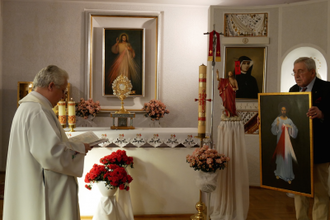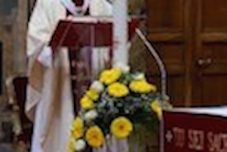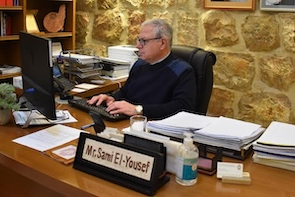US: New Jersey church presented with special Divine Mercy painting

Consecration of Divine Mercy Painting, Warsaw
Immaculate Conception Church, Mahwah, New Jersey, has been presented with the gift of a painting of St Faustina's vision of Jesus as the Fountain of Mercy. Janusz R Golebiowski, a Polish artist, painted this new interpretation of St Faustina's vision. Golebiowski is a long-time friend of Terri and Rob Herpst, Immaculate Conception parishioners who were active in the recent renovation of the parish's church.
Mr Golebiowski said: "I wanted to do something that would add to some of the wonderful artwork that my friends had described to me that is a part of the renovation their parish worked so hard to bring about".
Fr Manolo Punzalan said: "We renovated this church during the time of the Covid-19 Pandemic. We pleaded for God's Mercy to help us. An inspiration came to me that we dedicate a Wall of Mercy in our church as the devotion to the Divine Mercy is already growing among our parishioners".
Terri Herpst described the problem of fitting the Divine Mercy painting into the renovated church. She explained that " the church has eight marble panels in the wainscotting that are all the same size. Seven of the panels have two of the stations of the cross mounted on them and we had to fit the painting into the last one, so we needed a custom size and Janusz said he would paint it for us". There has been an empty frame hanging in the church since it reopened at Christmas. Ms. Herpst added that "it will be such a blessing to have the empty frame filled with the image of Divine Mercy." Golebiowski and Rob Herpst are old friends who worked together during the time of social revolution in Poland that was supported by the Church and Solidarity.
St Faustina, a Polish nun, had a vision of Jesus in 1931 while she lived at a convent in Plock, Poland. Jesus told her to paint the image she saw of him with the signature "Jesus, I trust in You" (in Polish: "Jezu, ufam Tobie"). Jesus told her this image is to be venerated throughout the world and the souls that venerate it will not perish. Jesus also told her that the Divine Mercy image was to be "solemnly blessed" on the first Sunday after Easter which is to be the Feast of Mercy.
Golebiowski's neighbour in the Warsaw suburb Lomianki, Ewa Wysga, suggested that the painting should be consecrated on Divine Mercy Sunday at Plock where St Faustina had her vision. Ms. Wysga said "we were worried that this might not happen as planned, since all of Poland was in lock down due to Covid" But, she added, "Janusz and I are exempt since we had both been vaccinated and Lomianki is only a few kilometres from St Faustina's Warsaw convent". With the help of Ms Wysga, Golebiowski connected with sister Maria Kowalczyk, the Mother Superior of Saint Faustina's first convent, the Order of Our Lady of Mercy in Warsaw. Ewa's original idea to have the painting consecrated at Plock had been frustrated by a nationwide Covid quarantine in Poland that extended until 18 April .
Ms Wysga and Janusz asked Sister Kowalczyk if she could arrange for the consecration of the painting. Golebiowski recounted that Sister Kowalczyk said she "would be delighted to have this done at our convent -I will ask Fr Julian". A few days later Golebiowski learned that Sister Kowalczyk had arranged for Fr Julian to consecrate the painting on the feast day of Divine Mercy - April 11th. The consecration was celebrated privately at the convent's chapel by Fr. Julian Gadek, CSMA, a Michaelite Father who is the Chaplin of the Warsaw convent.
The second Sunday of Easter was officially established as the Sunday of the Divine Mercy by Pope John Paul II in 2000 when he canonized St Faustina. St Faustina first entered the convent of Our Lady of Mercy in Warsaw at the age of 20 in 1925. Fr Gadek's order, The Congregation of Saint Michael the Archangel, is one of the 30 officially recognized orders of the Salesians.
The convent of Our Lady of Mercy is near the Warsaw Ghetto and was a sanctuary escapees from the Ghetto and for Ghetto fighters during the WW2 uprising. The Nazi's destroyed the convent and adjacent church after the uprising and the communist regime interfered with its reconstruction. But, during the years of the social revolution led by Solidarity and the Church, the site became a haven for dissidents after an artistic event titled Znak krzyża was held there to explore links between culture and religion. There were 106 painters, sculptors and photographers displayed their works accompanied by theatrical plays, installations, performances, concertos and recitals by first-rate Polish artists. Znak krzyża was a groundbreaking art experience which established a new role for the Divine Mercy church. Other art initiatives followed and from 1983 to 1985 the church site had the status of a nationally recognized dissident cultural center and art hub. Meanwhile, the Church reclaimed the ruins and did a crude temporary renovation and masses were regularly celebrated at the site in spite of the claim of nationalization of the premises by the Communist government which began its demise after the Round Table talks of 1989. Despite haphazard renovations, the complex did not reopen in its present form until 2007 after a comprehensive professional renovation.


















